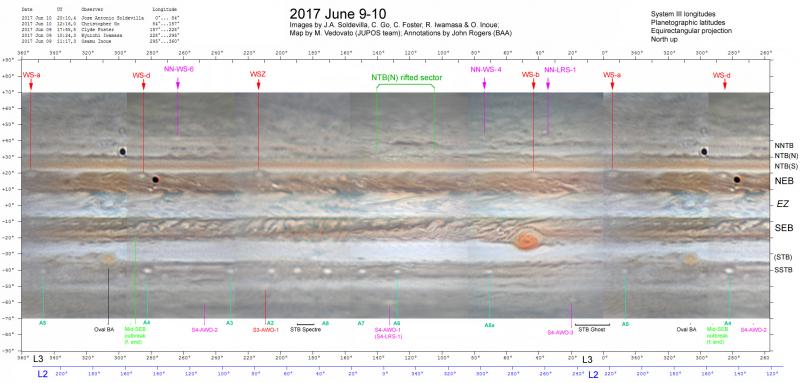2016-17, Report no.11: Update on the NEB expansion event.
The North Equatorial Belt (NEB) has shown remarkable activity this apparition, as described in our previous reports, nos.4 & 6 & most recently no.10 (https://britastro.org/node/10328). Since that report, it has become clear that the NEB has undergone a complete NEB expansion event, which has developed rapidly since late last year. It appeared to be initiated by several outbreaks of unusually northerly and slow-moving ‘rifts’, and these may in turn have been initiated by last autumn’s dramatic outbreak on the NTBs jet and the consequent intense turbulence in the NTropZ, producing near-simultaneous upheaval of the NTB and NEB comparable to that of 2012. This complete expansion event occurred about a year after the regression of a ‘failed’ expansion event in early 2016.
Now it is clear that multiple anticyclonic white ovals (AWOs) and cyclonic dark ‘barges’ are forming, as is typical after a NEB expansion event, although it may be happening unusually early this time. They are labelled on a recent whole-planet map (Fig.1; north up. L3), and on the JUPOS chart (Fig.2, with the same map with south up, L2), which shows their development and motion. We are now observing this process in great detail, with ground-based as well as JunoCam images. Anticyclonic vortices including white ovals (AWOs) have been forming since January. Initially they were small and had a very wide range of speeds, but the larger ones have been merging with smaller ones and their drift rates have converged towards more typical speeds. AWOs WS-b and WS-c apparently merged on or about May 20 (Fig.3): they were entangled in a single complex on May 19, then there was just a diffuse, dull-white oval from May 20 onwards. WS-a collided with another small one on June 14 (Fig.4); this interaction may not yet be complete.
In my report on ‘Juno at Perijove-6: The major belts from Perijove-1 to -6’ (https://britastro.org/node/10478), the JunoCam close-ups of the NEB from each perijove were assembled. The PJ6 image (May 19) was expected to capture an unusual pale sector which had evolved from extensive rifting, but this had apparently reverted to normal, so this was the least-disturbed NEB sector imaged. On the other hand, the image unexpectedly captured a striking anticyclonic vortex in the expanded northern NEB, apparently a new feature and only just large enough to be seen from Earth. It could also be seen in Chris Go’s superb images around the same time (small grey ring ‘J’ at L2 = 10 in Fig.5), but not earlier.
Fig.5 also shows a similar vortex (‘K’ at L2 = 344) which probably existed by May 12 and certainly by May 27. This is in a very dynamic sector of the NEB, close to where the major rifts had appeared several months ago, and Fig.5 shows another rift erupting there on May 17, as well as a possible new barge (the small dark brown spot ‘B’ at L2 = 341). This putative barge was already entangled in narrow streamers from residual rift activity on May 12, but on May 17 a brilliant white spot erupted on its south edge, then expanded into a new rift over the following days, both sinuously southeastwards in the NEB, and curling around vortex K (May 24-25), which thus became a more distinct oval by June 3.
Meanwhile the long-lived white spot Z (WSZ) has resumed its AWO appearance, but still surrounded by a broad dark grey collar. A small white spot near the latitude of the retrograde jet retrograded to the south edge of the grey collar on May 26-27, and disappeared soon after, but seems to have halted the usual rapid motion of WSZ, at least temporarily; and other such spots were approaching WSZ.
The figures are in this ZIP file: Report-no-11_NEB_Figs.zip
Here is a miniature of the map, Figure 1:

| The British Astronomical Association supports amateur astronomers around the UK and the rest of the world. Find out more about the BAA or join us. |
